Wondering what you need to prepare a very healthy breakfast? Some leftover rice, lots of water, shallots, and buttermilk. Interesting huh? But yes, that’s all you need to prepare this natural coolant and healthy breakfast called Neeragaram or Pazhaiya Sadam Kanchi – Leftover Rice Porridge or gruel. Today I am sharing how to prepare the neeragaram with step-wise pictures and all the health benefits that come with it.
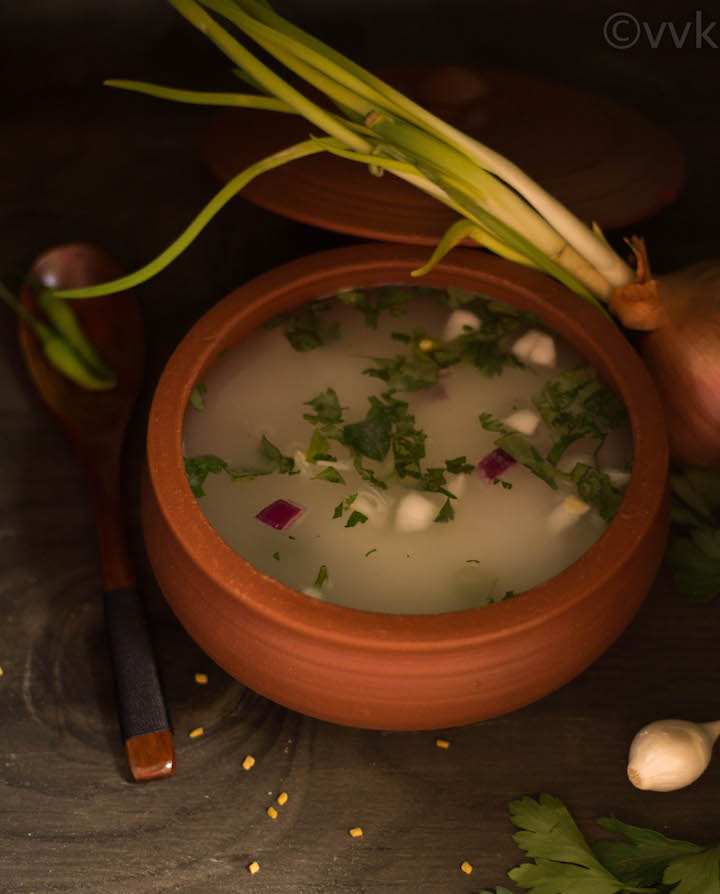
Leftover Rice Porridge or Neeragaram
Like Nannari Sarbath, Neeragaram also takes me back to my Periyakulam days. Kambu Koozh and this pazhaiya sadam are one among the most common breakfast among the field workers, especially during summer. Somehow all the simple and healthiest foods are termed as poor man’s diet. I am so glad that it is changing these days and all these healthy foods are being revived.
Other Names For Neeragaram in the Other Indian States
It is called soru thanni, neecha thanni, pulichathanni, nisineer, pazhaiya sada kanchi, and whatnot. Every culture interprets it in their way. When I shared the neeragaram picture on social media, one of the users shared its significance in Orissa. And then I went ahead and explored more about it.
We call Neeragaram as Pakhala in Orissa, and it is quite popular in Bengal, Assam, Jharkhand, Chhattisgarh. It is known by the name paani bhat, Panta bhat, poita bhat. So many names right?
Guess what, Orissa celebrates this dish in a unique way. (Source: Wiki) 20 March is declared Pakhala Dibasa (Universal Pakhala Day) by Odias worldwide. Hence, in a move to promote Odia food, the people of Odisha celebrate 20 March as Pakhala Dibasa and they have pakhala on 20 March to welcome the summer season.
Health Benefits of Leftover Rice Porridge
We all now know, Leftover Rice Porridge / Neeragaram is basically cooked rice soaked overnight. This overnight soaking helps with fermentation and makes the rice rich in starch. When we consume this starch-rich rice porridge, it keeps us full for a longer time.
Buttermilk, fenugreek seeds along with shallots make it a perfect natural coolant making it the perfect summer drink. In addition, the nativespecial mentions that it is ideal for ulcer and can address all intestinal problems.
So, without any further ado, here is the Neeragaram Recipe.
Leftover Rice Porridge Recipe
Ingredients:
- Cooked Rice – 1 cup
- Water – 3 cups
- Butter Milk – 1 cup
- Salt – ½ tsp
- Fenugreek Seeds – ⅛ tsp
- Shallots – 2
- Green Chili – 1
- Cilantro, chopped – 2 tbsp
- Curry Leaves – 5
Steps:
- Add 3 cups of water, fenugreek seeds, and salt to the cooked rice and leave it overnight.
- Peel the shallot skin and chop it. Also, cut the green chilies.
- In the morning, mash the rice nicely and add the buttermilk, chopped shallots, cilantro, chopped green chilies, and curry leaves.
- If required add more salt and serve your Leftover Rice Porridge chilled.
 Notes:
Notes:
- I prefer raw rice or boiled rice variety (sona masoori, seeraga samba, kaikuthal arisi or any millet varieties are preferable) for preparing this porridge.
- You can adjust water and buttermilk depending upon your consistency preference.
- Green chilies are optional. And as always, adjust the salt according to your taste.
📖 Recipe
Neeragaram | Leftover Rice Porridge
Ingredients
- 1 cup Cooked Rice
- 3 cups Water
- 1 cup Butter Milk
- ½ tsp Salt
- ⅛ tsp Fenugreek Seeds
- 2 Shallots
- 1 Green Chili
- 2 tbsp Cilantro chopped
- 5 Curry Leaves
Instructions
- Add 3 cups of water, fenugreek seeds, and salt to the cooked rice and leave it overnight.
- Peel the shallot skin and chop it. Also, cut the green chilies.
- In the morning, mash the rice nicely and add the buttermilk, chopped shallots, cilantro, chopped green chilies and curry leaves.
- If required add more salt and serve chilled.
Notes
- I prefer raw rice or boiled rice variety (sona masoori, seeraga samba, kaikuthal arisi or any millet varieties are preferable) for preparing this porridge.
- You can adjust water and buttermilk depending upon your consistency preference.
- Green chilies are optional and as always adjust salt according to your taste.
Nutrition
I am not a nutritionist. The nutritional information is provided as a courtesy and is an estimate only. It varies depending upon the product types or brands.
P.S. Follow my Pinterest boards for more healthy and delicious recipes.



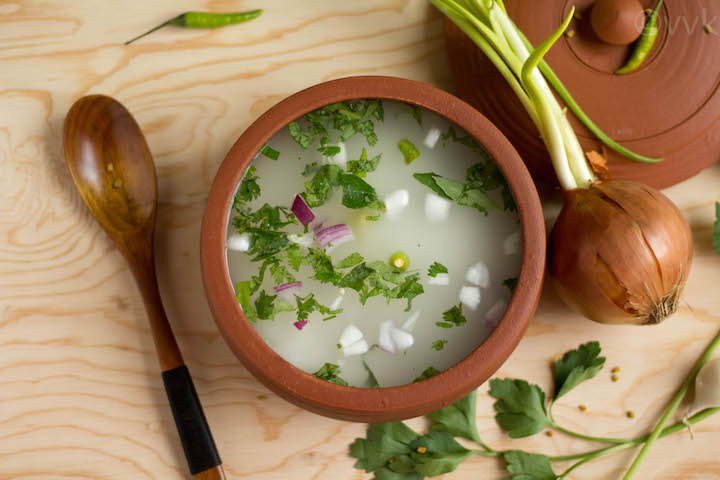
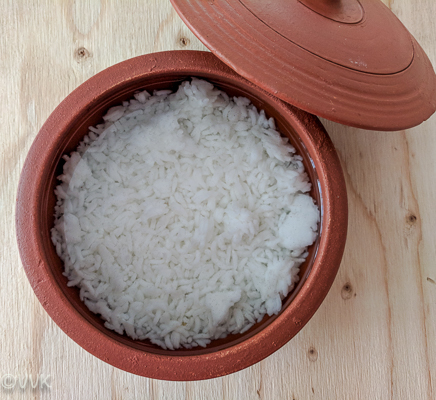
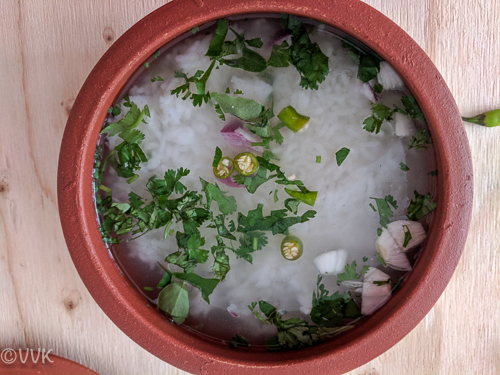
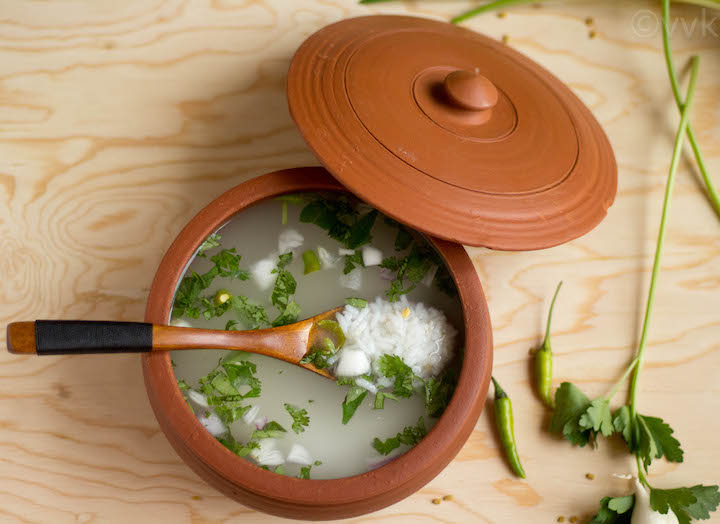
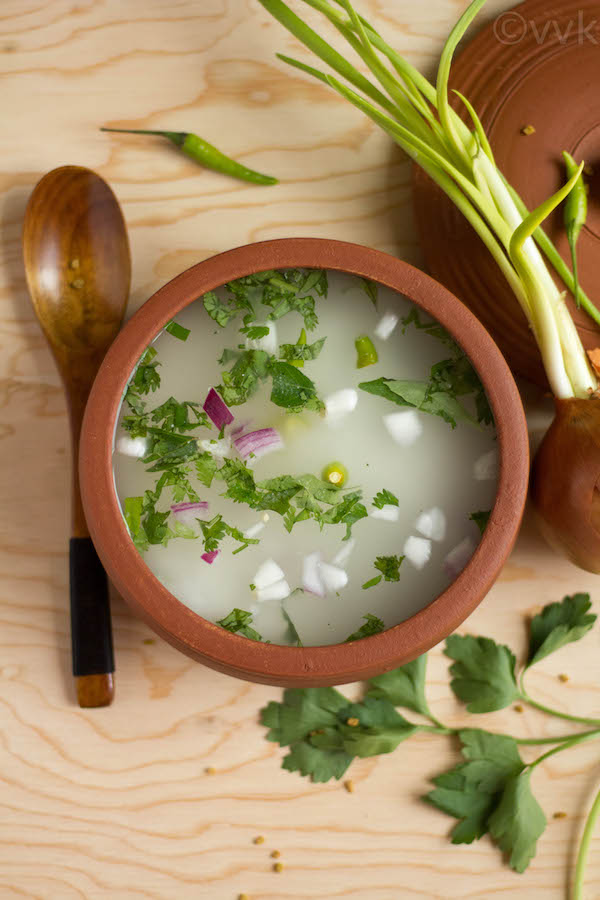
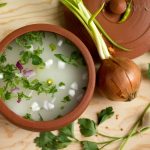
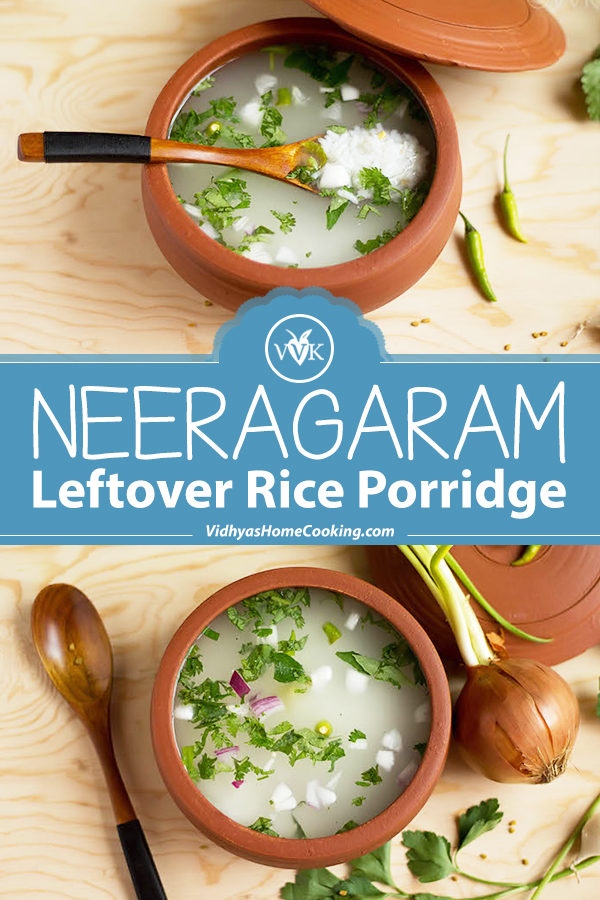

Hi, can I use raw rice instead of cooked rice?
No you have to use only cooked rice.
Thanks for the recipe and advise on health benefits. I make the raw rice in cooker. As soon as i take the rice out, I take 2-4 laddles of rice and soak it in water and keep it closed at about 2 pm in the afternoon. Next day I consume the water at about 8-9 am.
Am I doing it right?
We are looking for fermented rice and the gruel. As long as it’s fermented, it good.
I stay in Canada n it’s cold temperatures. Would the rice still ferment in 12 hours??? Or is there any other way??
It’s hard in cold temperature. You can keep it inside the oven with the lights on.
How long can the rice water be kept? Will it go bad or lose its properties if kept for long?
After making the porridge, I would consume it right away. You can soak the rice upto 18 hrs but not more than that.
Can I make it sweet..that is add sugar and milk in the morning instead of buttermilk shallots etc?
You can definitely do it. In that case don’t add other condiments.
Can it be made with brown rice and any harm if basmati rice are used?? Thanks
Brown rice yes, but with basmati, the taste will be different. I haven’t tried with basmati before.
Hi,
Is it necessary to soak in earthen vessel? Would it be the same if left in a steel vessel?
Also, is it ok for consumption in slightly cooler weather as well, like 18°C, or only to be had in summer?
Thanks.
You can use stainless steel vessel. The ingredients that we use are coolants so we recommend using them in summer. Everybody reacts in a different way. You can give it a try once the temperature is at least 20 deg C plus.
Thank you so much for the detailed recipe. When i cook rice i usually drain the excess starch. Should i soak the cooked rove in the cooking water or should i drain as usual and then add plain water for fermentation?
Soak the rice in plain water. You can use the excess starch to make porridge. Just add milk and sugar to it or buttermilk and salt to it and relish it. But for this one, soak the cooked rice in plain water.
Usually how long should I leave the water ,as in 12 hrs it doesn’t ferment..pl reply
In order for it to ferment, depending upon the weather it might take somewhere between 15 to 18 hours. When I make carrots kanji, I let it sit for 48 hours. This one I did not allow it to fully ferment. I hope I answered your question. Sorry about the delay.
Thanks ?? a lot , that was so nice of you to reply! I thought you would not !that makes a great blogger that’s you …tc Thank you
Hi,
I am new to this recipe and adopting this mostly for probiotic qualities. Although, I am big fan of southern Indian cuisine. We use Basmati rice at home. Which variety of rice do you recommend for this? Can I add curd in the night and soak in that water? Shall I add salt while cooking rice for this preparation? Thank you in advance :)
I would recommend raw rice or par-boiled rice variety. I haven’t tried with basmati rice though. You don’t need to add salt while cooking. And yes you can add little curd in the night. Do not much. I hope this helps and sorry for the delay in the response.
This is absolutely delicious! There are only two of us, so I cut down on the liquid a bit. I was also skeptical as the ingredients were things I don’t usually have for breakfast. I was sooo wrong! I can’t wait to make it again.
Thanks so much. Glad you liked it. :-)
You have done a research on Neeraharam. So much of details. Interesting indeed. We keep the left over rice refrigerated and the next morning we add all thadka and enjoy, the Neeraharam with Shallots, Maavadu. Nostalgic. Thanks Srividhya.
Thanks much. :-)
shows resourcefulness! I’m sure it’ll be tasty!
Yes, it is healthy and tasty. Thanks much Arv!